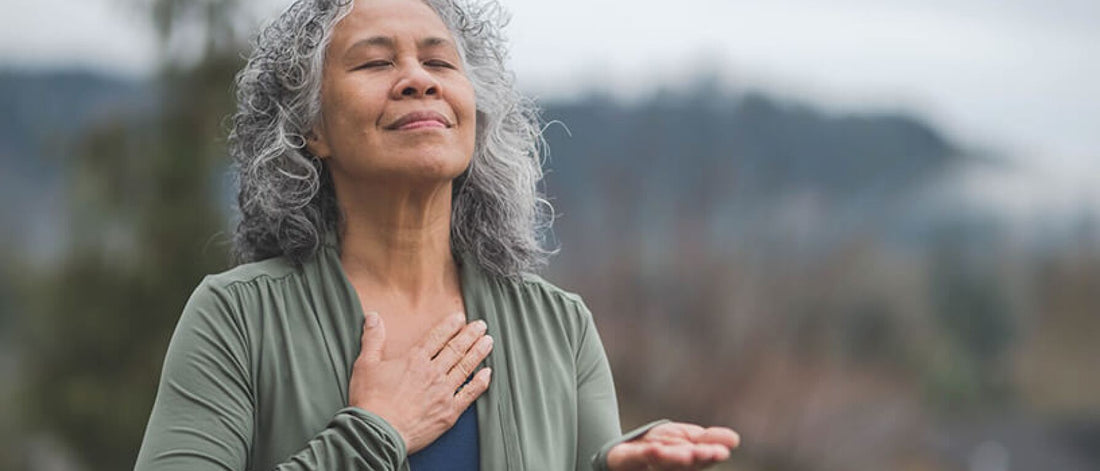Do you consistently wake up in the morning feeling tired or a bit out of sorts? We each have our ways of coping, such as grabbing a cup of coffee or pushing your way through it to prepare for the day.
How you start the morning easily sets the trajectory of the day, and it doesn’t help if it starts off a bit rocky. If you want to feel energized and refreshed in the morning, try something new the next time you wake up and breathe!
Martial artists, yogis, and Buddhist monks (to name a few) have long known the power of controlling the breath, utilizing many different types of breathing techniques. According to Ayurveda, your mind and breath mirror each other. A quiet mind leads to a quiet breath. A turbulent mind leads to disturbed breath. The same can be said for the effect of the breath on the body as a whole and vice versa. Thus, when you learn to regulate your breath, you can influence both your physical and emotional states.
Research also shows that changing breathing patterns restores balance to your stress response system in the following ways:
Pranayama, one of the eight limbs of yoga, refers to breathing techniques designed to master your vital life force in order to expand awareness and increase integration between mind and body. Ultimately, the purpose of pranayama is to help ease suffering and achieve self-realization. While self-realization might not be your end game, it’s helpful to know a bit about the philosophy when starting a morning breathing practice. Just knowing that by connecting with your breath you are also connecting to a universal energy can bring a sense of awe and deep respect for the practice.
In general, it’s recommended to perform 5-10 minutes of pranamaya in the morning and evening. If you have a morning meditation practice, it’s best to perform pranayama first. It begins to focus attention inward and reduces the scattered thoughts of the mind. Upon completion, it’s a comfortable transition into meditation. Here are some other tips to keep in mind:
Looking for more ways to squeeze some nourishment into your busy day? Learn how to use one of the best tools you have—your breath—to feel less stressed anytime, anywhere with Breathwork, our self-paced online course. Learn More.
How you start the morning easily sets the trajectory of the day, and it doesn’t help if it starts off a bit rocky. If you want to feel energized and refreshed in the morning, try something new the next time you wake up and breathe!
The Importance of Breath
Breath is your primary life-giving impulse that can often be taken for granted. Since it is part of your autonomic nervous system, it performs its function dutifully during your entire life without your awareness (for the most part). However, it’s possible to bring this function of your body under conscious control through the yogic practice of breathing exercises known as pranayama. These exercises can enhance your physical, mental, and spiritual well-being.Martial artists, yogis, and Buddhist monks (to name a few) have long known the power of controlling the breath, utilizing many different types of breathing techniques. According to Ayurveda, your mind and breath mirror each other. A quiet mind leads to a quiet breath. A turbulent mind leads to disturbed breath. The same can be said for the effect of the breath on the body as a whole and vice versa. Thus, when you learn to regulate your breath, you can influence both your physical and emotional states.
Research also shows that changing breathing patterns restores balance to your stress response system in the following ways:
- Reduces anxiety and depression
- Increases energy levels
- Increases body relaxation
- Decreases stress and overwhelm
- Strengthens immune system
- Improves mental concentration
Importance of a Morning Practice
Early morning is a special time of day. The air is still and sweet, and the birds are singing; all of nature is priming for a new day. Your nervous system is built to respond to the qualities of morning in the same way—ready for renewal. Even if you live in the city, you can still feel that there is something pure about this time of day. The more you tune into the energy of morning, the more it can help you set the tone for a better day. Start your morning on the right foot by developing a routine that includes some breathing exercises, or pranayama, to help enliven your spirit.The Philosophy behind Pranayama
Prana is a Sanskrit word referring to the vital life force that animates all living things. It nourishes and supports every cell and tissue in the body and aids in the circulatory processes of the body.Pranayama, one of the eight limbs of yoga, refers to breathing techniques designed to master your vital life force in order to expand awareness and increase integration between mind and body. Ultimately, the purpose of pranayama is to help ease suffering and achieve self-realization. While self-realization might not be your end game, it’s helpful to know a bit about the philosophy when starting a morning breathing practice. Just knowing that by connecting with your breath you are also connecting to a universal energy can bring a sense of awe and deep respect for the practice.
The Practice of Breathing
There are many different types of pranayama exercises, all with various benefits—some calm, some stimulating, and much more. Depending on how you feel in the morning will determine which exercise to use. Here are a few common ones:In general, it’s recommended to perform 5-10 minutes of pranamaya in the morning and evening. If you have a morning meditation practice, it’s best to perform pranayama first. It begins to focus attention inward and reduces the scattered thoughts of the mind. Upon completion, it’s a comfortable transition into meditation. Here are some other tips to keep in mind:
- Blow your nose before you start and keep some tissues nearby.
- Avoid any straining—if you feel dizzy or experience any discomfort, stop for a moment and sit quietly until you feel better.
- Make sure you are in a quiet room free of distractions.
- If you feel anxious, stop the exercise and rest until the sensation passes.
- Try a vigorous breath first (bhastrika or kapalabhati), followed by a calming technique (nadi shodhana). Be sure to take a small break in between.
- Start off slow, maybe perform a one-minute exercise for a week so that you can allow your body to adjust, and then work up to 5 or 10 minutes—whatever feels comfortable.
Morning Breathing Exercise
This is an easy exercise to get you started. It’s called the Complete Belly Breath.- Place one hand on your belly, relax the abdominal muscles.
- Slowly inhale through the nose, drawing the air into the bottom of your lungs. You should feel the abdomen rise.
- On the same inhale, feel the rib cage expand outward as the breath move upward until the collar bones rise.
- Pause for a moment, then exhale out the mouth gently from the top of your lungs toward the bottom.
- At the end of the exhalation, draw your belly button toward your spine, pushing any residual air out of the bottom of the lungs.
Looking for more ways to squeeze some nourishment into your busy day? Learn how to use one of the best tools you have—your breath—to feel less stressed anytime, anywhere with Breathwork, our self-paced online course. Learn More.






















